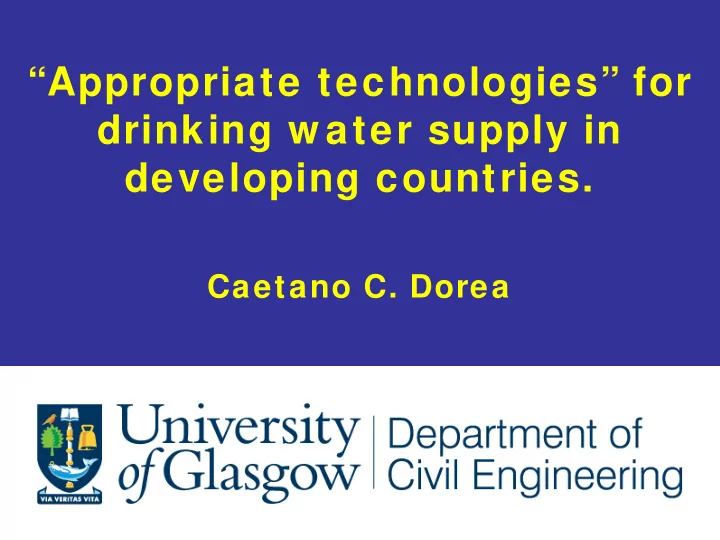

“Appropriate technologies” for drinking w ater supply in developing countries. Caetano C. Dorea
Look what 22000 litres of water has done for me!
Infectious diseases Caused by: • Bacteria; • Viruses; • Protozoa.
Water-related disease • Related to w ater or impurities in the w ater; • Person to person; • Animal to person; • Does not include illnesses caused by chemical contaminants.
Faecal-oral route “Hardw are”: • Water supply; • Sanitation; • Drainage. “Softw are”: • Hygiene promotion.
Faecal pollution
Water-borne diseases • Transmission: through ingestion of contaminated w ater; • Improvement of supplied w ater quality; • Prevention of the use of contaminated or unprotected sources.
Water-w ashed diseases • Transmission: depends on w ater availability and quantity; • Personal and domestic hygiene; • Increase in w ater coverage, quantity and continuity.
Water-w ashed diseases
Water quality Worst w e can tolerate ? Best w e can achieve ? -Developing countries; -Industrialised countries; -Appropriate technologies; -“High tech” approach; -Acute risks (e.g. w ater- related disease). -Precautionary principle (chronic risks).
Appropriate technologies • …techniques that can be implemented/operated by the beneficiary community; • Closely tied to “sustainability” or “maintainability”; • Depends on: – Available skills and resources; – Cultural and environmental settings.
Developing countries • Humanitarian emergencies (Asian Tsunami, Pakistan Earthquake); • Development (Rw anda); • Collaborations w ith Oxfam and Univ. of Surrey.
Development
Service indicators: 1. Coverage (maximum number of people); 2. Quantity (varies w ith climate and cultures: 20 to 120 L/head/day); 3. Continuity (days/year and hours/day); 4. Quality; 5. Cost.
Rw anda • 1994 genocide: •800000 victims •100 days of massacre • Mass exodus • Mass return in 1996
Case study: Rw anda • Nyabw ishongw ezi • 18000 people • Water???? • Iron in groundw ater • Little yield from w ells
Umuvumba River
Multi-stage filtration Up-flow gravel filters in series Slow sand filter • Reduce particulate loadings to slow sand filters; • Together w ith SSF form multi-stage filtration systems.
Improvement: not ideal, but much better!
Problems though! • Low usage → low income from tarriffs; • No community ow nership → no previous community; • High costs of pumping diesel; • By 2004 WTP stopped w orking.
Not as bad as... Ntoma
Continuous flow sedimentation basin (w hen operated properly)
(w hen not operated properly)
Abandoned pre-filters Unused slow sand filters
Emergencies
Microbiological safety: no pathogens
Water must look and taste nice…
Queuing time less than 15 min
Less than 3 min to fill a 20 L vessel
Maximum distance 500 m
Or else…
Quantity vs. Quality? • Most diseases due to inadequate amounts of w ater for hygiene; • Priority for sufficient quantities; • Large amounts of good quality w ater is better than… • Small amounts of excellent quality w ater.
Emergency phases > 20 to 25 L/p/d 10 to 20 L/p/d 1 to 5 L/p/d Relative stability Stabilisation (search for more (Other needs: Survival durable/sustainable bathing, laundry, (drinking and w ater supplies) livestock) cooking) Immediate Late emergency Post-emergency (1 st w eeks) (1 to 6 months) (> 6 months or years)
Water treatment and supply Sanitation Hygiene promotion
The Asian tsunami…
Oxfam Field Upflow Clarifier Kit
Outlet Water level Fabric polishing filter Floc Blanket Flocculator Drainage Inlet Yield = 10 m 3 /h
FUC run no. 3 - 9640 L/h; alum dose = 40 mg/L 1000 Raw water Treated water 100 Turbidity (NTU) 10 1 0.1 0 1 2 3 4 5 6 7 Run time (h)
Simplified field jar-test.
Service indicators: 1. Coverage (maximum number of people); 2. Quantity (varies w ith climate and cultures: 20 to 120 L/head/day); 3. Continuity (days/year and hours/day); 4. Quality; 5. Cost.
Sustainability/maintainability: • Efficient and reliable service at desired level; • Financially and technically feasible to maintain; • Can be used efficiently w ithout negative effects on the environment.
Conclusions • By-the-book designs only w ork if they are run by- the-book (skills and resources); • Adequate design is needed to maximise donor funding and public health impact; • More advanced processes (e.g. coagulation) can be “suitable” or “appropriate” in certain circumstances; • Main bottleneck is know ledge transfer! • Tarrifation (maintenance) must also be considered.
So, w hat’s the w ay forw ard? 1. I don’t know … still w orking on it! 2. Community involvement! 3. Capacity building – “softw are”; 4. Current trend: decentralised household treatment approach; 5. Must consider improvement to livelihoods… not just health.
Thanks!!! Any questions???
Recommend
More recommend